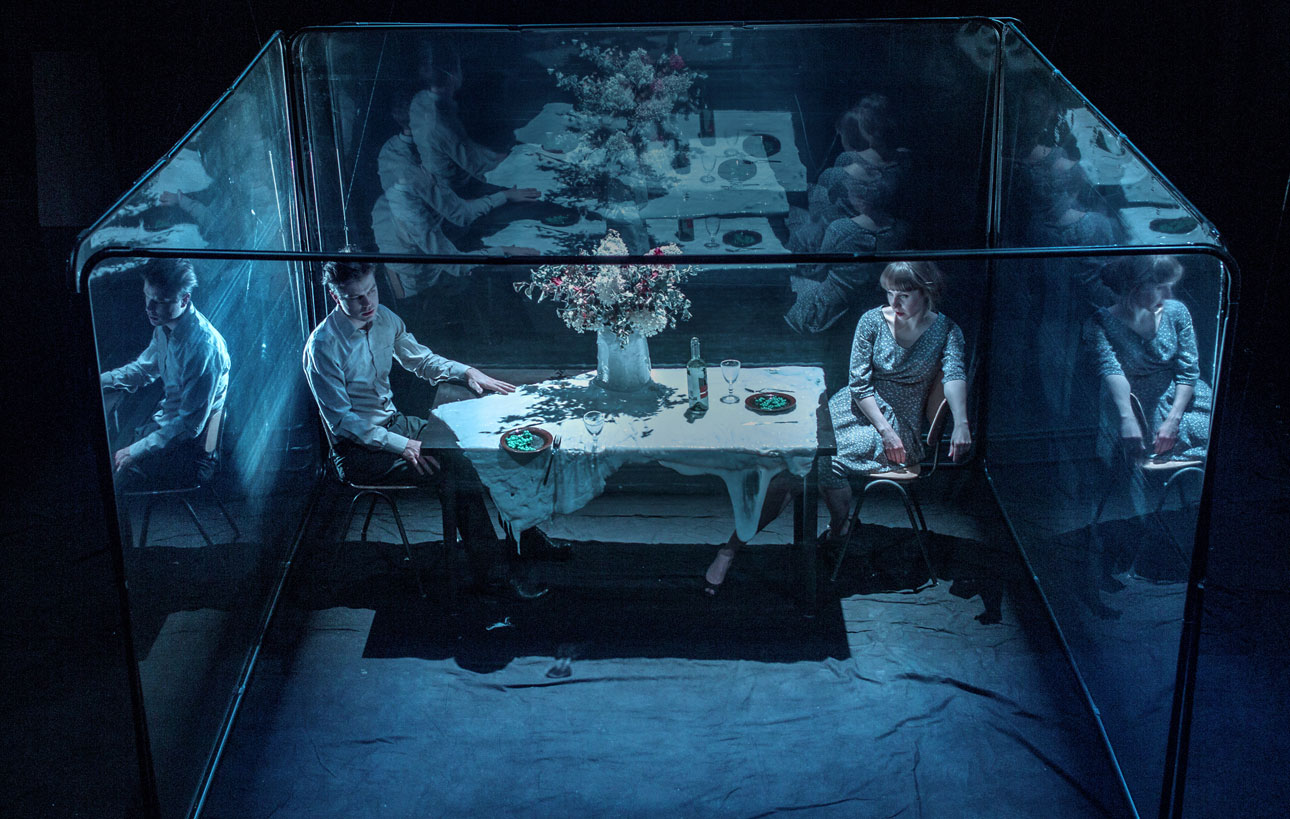Lähtö is a cool show. Its colour palette is soft greys and ice blues. Its two performers, a man and a woman, are forever poised in beautiful shapes – held back, restrained, even when in the throes of passion. They take their time, they repeat, they are not afraid to stop, to create the image – or perhaps we should say, the shot. For Lähtö is a cinematic show, set on a big, broad stage, with a deep multi-layered set that eloquently moves us from 2D to 3D perception from scene to scene. It features larger-than-life projected monochrome images of faces that gaze nonchalantly away from each other; or melancholy sheets of rain tumbling down; or the rolling waves of a seascape peeked through a raised drape. As well as using moving image as a theatrical element, it also – knowingly, teasingly – constantly references the world of cinema. Not only the Michelangelo Antonioni movies cited as influences (most notably L’Eclisse and Blow Up), but also the Nouvelle Vague films of Truffaut and Goddard, and the Noir tradition. Ingmar Bergman is never too far away, either. Cigarettes are smoked, wine glasses drained, high heels kicked off, overcoats shrugged into then discarded, drapes pulled open and closed. And still the rain falls, the wind sighs, and the waves roll on.
Our two performers, Kalle Nio (visual artist and magician, and founder and director of the company) and Vera Selene Tegelman (dancer and co-choreographer of the piece) play a couple in a disintegrating relationship – or perhaps, reevaluating the relationship after the death (literal or metaphorical) of their love. We are in a Bardo, a limbo world, where memory and imagination, dream and reality, play out. We witness the age-old tussle between Eros and Thanatos, love and death – the tug-of-war played out by the bodies on stage in interaction with the very many objects employed. An elaborate system of drapes and pulleys transform prissy living room curtains into the billowing sails of a ship. A great big perspex box cleverly explodes out into a variety of geometric shapes, providing the canvas for a cleverly reworked version of the classic Pepper’s Ghost trick, in which performers and their ‘ghosts’ dance an intensely melancholy choreography, and we lose track of which is real human figure and which is illusion. The couple, embracing on a table-top, find themselves trying to pull themselves clear of gluey threads of cloth that cling to their bodies. The classic Lecoq/Decroux ‘overcoat-wearing body with many hands’ scene makes an appearance, all done very eloquently. In a rare moment of light relief, Kalle Nio wrestles with a seemingly self-animating shirt that fights back as he tries to iron it. Lovely and wonderfully well executed though this scene is, it has a very different tone to the rest of the piece, and I’m not sure it belongs…
The performances can’t be faulted, the visual imagery is gorgeous, the ideas beautifully executed, and yet – I never fully warm to the show. I like it, I admire it, but I don’t absolutely love it. The glacial cool is just a little too – chilly – for me. It is also that some of the power and magic – the actual magic tricks and the theatrical magic – is lost by being too close to the action. (The show is set at floor-level in the Platform Theatre’s malleable space, with raked seats going up from a point very close to the edge of the performance space. I’m in the second row, and feel practically on top of the show.) I find myself longing to see this show on a great big, deep, proscenium arch stage, the performers distanced from us for the full cinematic effect. It is a dilemma, because London – despite being a capital city in a country of theatre lovers – doesn’t actually have very many suitable spaces for epic visual theatre work of this nature.
There are some odd lighting design choices: in particular, one ice-white light, on-high, upstage right (which may have been intended to represent the moon or perhaps the North Star, who knows?), shines continuously – not only a distraction, but also disrupting the projected images. The sound design, on the other hand, is excellent. Composer Samuli Kosminem (who is known for his collaborations with the Kronos Quartet) weaves together the sampled sounds of sea and rain and footsteps and clinked glasses with girl-group pop candy and moody electronica to create a soundscape that beautifully complements and interacts with the visual imagery and live action. The opening section of the piece, in which our couple monotonously enact and re-enact a terse dinner together, is a wonderful example: the performers and the exaggerated Foley style sound effects (a knife scraped on a plate, a bottle emptied into a glass, a pair of heels clicking across the floor, a set of keys thrown onto the table) start off in perfect synchronicity, then the sequence disintegrates just enough to put it uncomfortably out-of-synch. It is one of many beautifully enacted scenes in which sound, physical action, object animation, and film all blend together harmoniously in service of the themes of the show.
Ultimately, Lähtö is a series of scenes that, taken individually, can’t be faulted – but the show never becomes more than the sum of its beautifully crafted parts.
Lähtö is presented at the London International Mime Festival 2018 in partnership with Jacksons Lane, and supported by the Finnish Institute in London / TelePART. For information and bookings for all the shows and workshops in LIMF 2018, see www.mimelondon.com
Featured image (top): Lähtö | Departure, photo Tom Hakala

